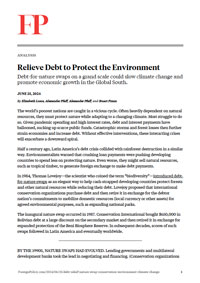Nicholas Institute for Environmental Policy Solutions
Publisher
The world’s poorest nations are caught in a vicious cycle. Often heavily dependent on natural resources, they must protect nature while adapting to a changing climate. Most struggle to do so. Given pandemic spending and high interest rates, debt and interest payments have ballooned, sucking up scarce public funds. Catastrophic storms and forest losses then further strain economies and increase debt. Without effective interventions, these interacting crises will exacerbate a downward spiral.
Half a century ago, Latin America’s debt crisis collided with rainforest destruction in a similar way. Environmentalists warned that crushing loan payments were pushing developing countries to spend less on protecting nature. Even worse, they might sell natural resources, such as tropical timber, to generate foreign exchange to make debt payments.
In 1984, Thomas Lovejoy—the scientist who coined the term “biodiversity”—introduced debt-for-nature swaps as an elegant way to help cash-strapped developing countries protect forests and other natural resources while reducing their debt.
Nature swaps could become a more powerful means of addressing these enormous and interrelated crises. To do so, this financial instrument must be reformed. We propose four changes, drawing on lessons from decades of nature swaps and evaluations of conservation and development policies.


